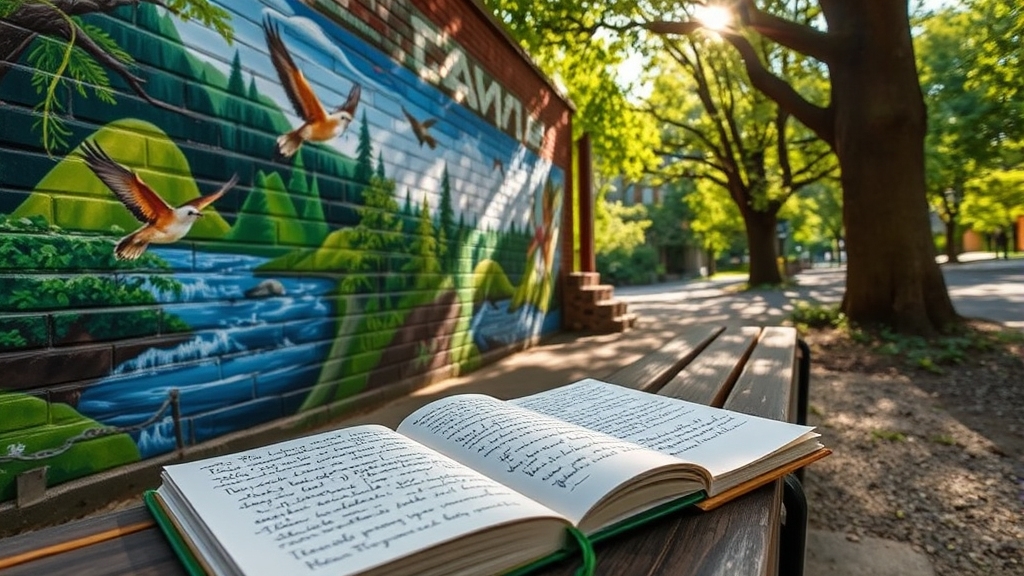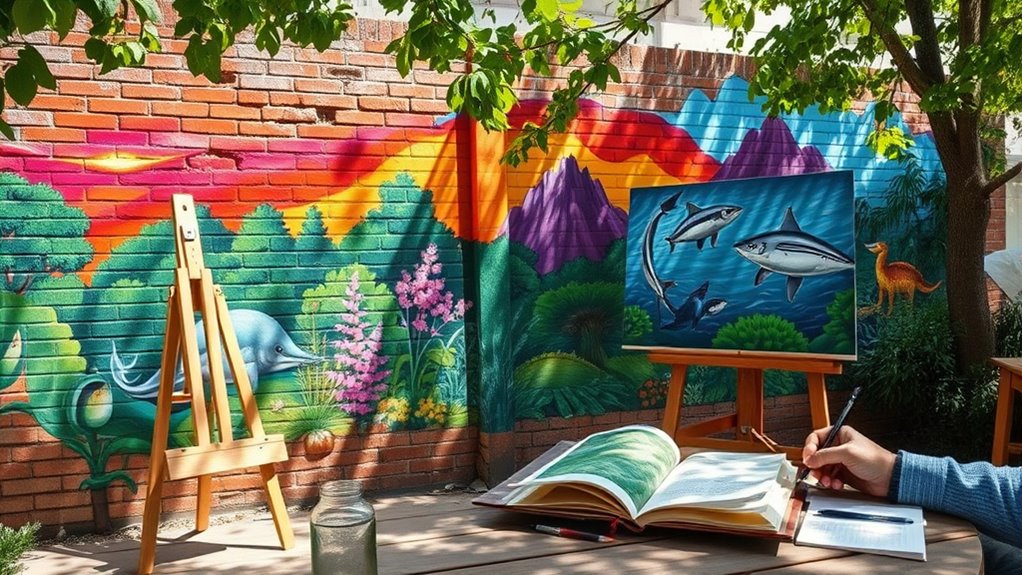Artists and writers inspire conservation by turning environmental issues into striking visual and literary stories that reach your emotions and spark action. They create murals, sculptures, and powerful words that highlight problems like deforestation and pollution, making them urgent and relatable. Their work encourages empathy, awareness, and community efforts, often using innovative technology to deepen impact. If you want to discover how these creative voices continue to shape environmental change, keep exploring further.
Key Takeaways
- Artists create eco-themed murals, sculptures, and installations that visually highlight environmental issues and inspire public awareness.
- Writers incorporate environmental themes into narratives, essays, and poetry to evoke empathy and motivate conservation actions.
- Creative expressions foster emotional connections, making ecological challenges relatable and encouraging community engagement.
- Technology like virtual reality and sound design enhances immersive experiences, deepening audiences’ understanding of conservation needs.
- Eco art and literary activism transform complex ecological issues into compelling stories that inspire action and promote sustainable practices.

Artists and writers have long played a pivotal role in sparking awareness and inspiring action for conservation. Their creative expressions can reach audiences in ways that facts and figures often cannot. Through eco art initiatives, they transform environmental issues into compelling visual stories that evoke emotion and motivate change. Whether it’s a mural highlighting deforestation or a sculpture made from recycled materials, these projects make ecological concerns tangible and urgent. You might find yourself moved by a vivid painting that captures the beauty of a disappearing landscape or inspired to support conservation efforts because of a provocative installation. Eco art initiatives serve as powerful tools to communicate complex environmental challenges in accessible ways, making the issues resonate deeply with viewers. They challenge you to see the world differently and recognize your role within it.
Similarly, literary activism mobilizes readers by weaving environmental themes into compelling narratives and essays. Writers use their words to reveal the often-overlooked impacts of pollution, habitat destruction, and climate change. When you read a passionate essay or a poetic reflection on ecological loss, you’re invited to connect emotionally and intellectually with the cause. Literary activism doesn’t just inform; it inspires action. It encourages you to question your habits, support sustainable practices, and participate in community efforts. Through books, articles, and poetry, writers make conservation personal, turning abstract statistics into stories that resonate on a human level. Their words can ignite a sense of responsibility and urgency, pushing you to become part of the solution.
What’s particularly effective about these artistic efforts is how they engage your senses and emotions. Eco art initiatives draw you into a visual dialogue, while literary activism appeals to your intellect and empathy. Both forms of expression break down barriers, making environmental issues relatable. You might find yourself sharing a striking piece of eco art or recommending a thought-provoking book, spreading awareness further. As a consumer of these creative works, you become an active participant in conservation narratives. Artists and writers aren’t just raising awareness—they’re empowering you to see your influence and take meaningful action. Their work reminds you that conservation isn’t solely a scientific or political issue; it’s a deeply human endeavor rooted in creativity and compassion. By engaging with eco art initiatives and literary activism, you’re part of a broader movement that harnesses imagination and storytelling to protect our planet. Additionally, understanding the role of projectors and display technology can help you better experience and share these works in various settings. Recognizing the importance of Cultural Intelligence can also enhance your appreciation of how different cultural perspectives influence conservation narratives and artistic expressions, fostering a more inclusive approach to environmental advocacy. Furthermore, incorporating sound design elements into eco art and literary presentations can deepen the emotional impact and immersive experience for audiences. Exploring virtual reality and immersive environments can further elevate the engagement and emotional resonance of conservation messages, making them more impactful.
Frequently Asked Questions
How Do Artists Choose Their Conservation Themes?
When choosing conservation themes, you often rely on visual symbolism and cultural narratives that resonate deeply. You might observe nature’s beauty or threats and translate those feelings into your art or writing. By exploring stories and symbols that connect people emotionally, you inspire awareness and action. Your choices reflect what’s meaningful in your community and personal experiences, making conservation themes powerful and compelling through your creative expression.
What Impact Do Writers Have on Environmental Policy?
You see, writers influence environmental policy through eco literature influence and policy advocacy techniques. By sharing compelling stories and highlighting urgent issues, you can sway public opinion and inspire policymakers. Writers often use powerful narratives to make complex environmental topics accessible, prompting action. Their work raises awareness, shapes attitudes, and encourages policy changes, proving that words can be an essential tool in driving conservation efforts and fostering a sustainable future.
Can Art Effectively Change Public Conservation Behavior?
You can see that art effectively changes public conservation behavior through visual storytelling and emotional engagement. When you experience powerful images or compelling narratives, they trigger feelings that motivate you to care about environmental issues. Art resonates on a personal level, making abstract problems tangible. By evoking empathy and awareness, art encourages you to adopt more sustainable habits and support conservation efforts, ultimately fostering a lasting impact on public behavior.
How Do Artists Collaborate With Conservation Organizations?
You might think artists rarely team up with conservation groups, but they actively engage through artistic activism, creating powerful visuals and performances that raise awareness. They collaborate by designing campaigns, murals, or exhibits that highlight cultural preservation and environmental issues. These partnerships make conservation messages more compelling, inspiring public action and fostering a deeper connection to protecting our natural and cultural heritage. Such collaborations amplify impact and inspire community involvement.
What Funding Sources Support Conservation-Inspired Art Projects?
You can find funding opportunities through various grant programs dedicated to conservation-inspired art projects. Many government agencies, like the National Endowment for the Arts, offer grants that support creative efforts promoting environmental awareness. Additionally, private foundations and environmental organizations often provide funding opportunities to help artists and writers bring their conservation-themed projects to life. Applying for these grants can give your work the resources needed to make a meaningful impact.
Conclusion
You might be surprised to learn that over 70% of people say that art and stories inspire them to care more about the environment. By sharing your own creations or supporting others, you can help spark that same passion in others. Remember, your voice and vision have the power to ignite change and protect our planet’s beauty for generations to come. Keep inspiring, because every effort counts in this essential conservation journey.




